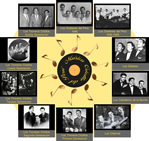 |
|
|
|
|
Video
Ana Pavlova (Manuel Covarrubias, Juan Valles Vargas)
|
 Vals Anna Pavlova (Анна Павлова). Interpretado por Los Troveros Criollos (Lucho Garland, Pepe Ladd y Humberto Pejovés).
Vals Anna Pavlova (Анна Павлова). Interpretado por Los Troveros Criollos (Lucho Garland, Pepe Ladd y Humberto Pejovés).
Este vals fue compuesto por Juan Valles Vargas y Manuel Covarrubias y grabado en 1956.
Anna Pavlova nació en San Peterburgo el 31.01.1881 y falleció en La Haya el 23.01.1931. Ella fue tal vez la mejor ballerina en la historia del ballet. El Perú tuvo la suerte de apreciarla durante una gira mundial en 1917, actuando en el Teatro Municipal de Lima. Su actuación causó tanto impacto entre los peruanos, que no solo impulsó el estudio del ballet, sino escritores y compositores le dedicaron artículos, poesías y canciones. Este es el caso de este vals, cuya letra fue compuesta por el poeta tacneño Juan Valles Vargas y al cual su amigo, Manuel Covarrubias le puso música.
Estas letras, la alegre música y las fantásticas guitarras de Lucho Garland y Pepe Ladd hacen de este vals un criollísimo homenaje del Perú a Anna Pavlova.
А́нна Павловна (Матвеевна) Павлова (31 января 1881, Санкт-Петербург, Российская империя — 23 января 1931, Гаага, Нидерланды) . Русская артистка балета и одна из величайших балерин XX века.
В 1910 году перешла на так называемое положение «гастролёрши», создала собственную труппу. Вместе с этой труппой гастролировала во многих странах мира. Среди них Перу, где она выступила в Teatro Municipal в Лиме, в 1917 году.
Имя Павловой ещё при жизни балерины стало легендарным. Скончалась она в Гааге, во время гастролей, 23 января 1931 года от пневмонии. По легенде последними её словами были: «Приготовьте мой костюм лебедя!».
Anna Pavlova was born on January 31, 1881, in St. Petersburg, Russia.
In February 1910 Pavlova made her first appearance in America, at the Metropolitan Opera House. Most of the American audiences had never before seen classical ballet, and critics did not know how to describe what Pavlova did on stage, although all agreed that it was wonderful.
Pavlova's final trip to Russia occurred in the summer of 1914. She was traveling through Germany on her way to London, England, when Germany declared itself at war with her homeland in August 1914. Pavlova's protection from and obligations to the czar and his Maryinsky Theatre had come to an end.
From this point until her death, Pavlova continued to make long, exhausting tours, always with her own company. She returned to America several times; she went to South America (Peru) in 1917.
Sir Frederick Ashton, former dancer and later one of the world greatest ballet choreographs, witnessed a life-changing event when he attended a performance by the legendary Anna Pavlova in the Municipal Theater in Lima, Peru at the age of 13, which made him decide that he would become a dancer.
'She was a spirit, a flame' said Ashton. 'She wasn't human.' "Seeing her at that stage in Lima was the end of me. She injected me with her poison and from the end of that evening I wanted to dance.'ANA PAVLOVA – LETRAS Siguiendo de la música, el movimiento armónico
las ideales sílfides de condición elástica
arrimanse al unísono bajo el poder sinfónico
en floración cromática como visión fantástica.
A veces tiene un pálpito emocional patético
que con intuición rítmica de una acción deífica
traduce su habla típica y adquiere un ser sintético.
Tal vez en esa cátedra selvática esotérica
Pavlova la Terpsícore emocional, mirífica
en el papel de alígera, libélula quimérica.
No existe en lo pictórico un cuadro más poético
ni habrá un ensueño célico que encierre mejor mímica,
la persuasión es gráfica y el lineamiento estético,
la evocación histórica y la volición anímica.
A veces tiene un pálpito emocional patético
que con intuición rítmica de una acción deífica
traduce su habla típica y adquiere un ser sintético.
Tal vez en esa cátedra selvática esotérica
Pavlova la Terpsícore emocional, mirífica
en el papel de alígera, libélula quimérica. |
|
« Regresar a la página anterior
|
|
|
|
|
 |